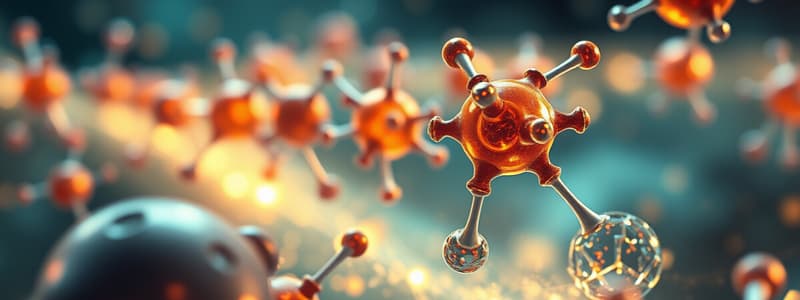Podcast
Questions and Answers
List the four major classes of macromolecules.
List the four major classes of macromolecules.
Carbohydrates, Lipids, Proteins, Nucleic Acids
Distinguish between monomers and polymers.
Distinguish between monomers and polymers.
Monomers are the small molecules that make up a polymer. A polymer is a long chain of monomers connected by covalent bonds.
Distinguish between monosaccharides, disaccharides, and polysaccharides.
Distinguish between monosaccharides, disaccharides, and polysaccharides.
Monosaccharides are simple sugars; disaccharides are two monosaccharides joined by a glycosidic linkage; polysaccharides are made from a few hundred to a few thousand monosaccharides.
Describe the formation of a glycosidic linkage.
Describe the formation of a glycosidic linkage.
What are fats?
What are fats?
What are phospholipids?
What are phospholipids?
What are steroids?
What are steroids?
What is an ester linkage?
What is an ester linkage?
What is a saturated fat?
What is a saturated fat?
What is an unsaturated fat?
What is an unsaturated fat?
Name the principal energy storage molecules of plants and animals.
Name the principal energy storage molecules of plants and animals.
What is a protein?
What is a protein?
What is a polypeptide?
What is a polypeptide?
List the four major components of an amino acid.
List the four major components of an amino acid.
What are the two types of secondary protein structures?
What are the two types of secondary protein structures?
What are four conditions under which proteins may be denatured?
What are four conditions under which proteins may be denatured?
What is a nucleotide?
What is a nucleotide?
What is a pyrimidine?
What is a pyrimidine?
What is a purine?
What is a purine?
What is a nucleoside?
What is a nucleoside?
What is ribose?
What is ribose?
What is deoxyribose?
What is deoxyribose?
Describe the three-dimensional structure of DNA.
Describe the three-dimensional structure of DNA.
What is a polymer?
What is a polymer?
What is a monomer?
What is a monomer?
What three macromolecules are polymers?
What three macromolecules are polymers?
What is a dehydration reaction?
What is a dehydration reaction?
What is hydrolysis?
What is hydrolysis?
What are simple sugars?
What are simple sugars?
In carbohydrates, what are the monomer and polymers called?
In carbohydrates, what are the monomer and polymers called?
What's a disaccharide?
What's a disaccharide?
Flashcards are hidden until you start studying
Study Notes
Major Classes of Macromolecules
- Four classes: Carbohydrates, Lipids, Proteins, Nucleic Acids
Monomers and Polymers
- Monomers: small, individual molecules that join to form polymers
- Polymers: long chains of monomers connected by covalent bonds
Types of Carbohydrates
- Monosaccharides: simple sugars; basic building blocks of carbohydrates
- Disaccharides: formed from two monosaccharides by glycosidic linkage
- Polysaccharides: large macromolecules composed of hundreds to thousands of monosaccharides for storage or structure
Glycosidic Linkage
- Creates bonds between glucose molecules, forming disaccharides like maltose
Lipid Structure
- Fats: consist of glycerol and three fatty acid chains linked via ester linkage
- Phospholipids: contain glycerol, two fatty acids, and a phosphate group; exhibit hydrophobic tails
- Steroids: include cholesterol and functional hormones
Types of Fats
- Saturated Fat: contains maximum hydrogen atoms in fatty acid chains, resulting in straight structures
- Unsaturated Fat: contains fewer hydrogens due to double bonds, creating kinks in the chain
Energy Storage
- Plants store energy primarily as starch
- Animals store energy as glycogen, synthesized in the liver
Protein Structure and Function
- Proteins serve in transport, storage, signaling, movement, and enzymatic functions; composed of folded amino acids
- Polypeptides are chains of amino acids linked by peptide bonds
Amino Acid Composition
- Four components of amino acids:
- Asymmetrical carbon
- Amino group
- Hydrogen
- R group (variable)
- Carboxyl group
Secondary Protein Structure
- Alpha Helix: coiled structure
- Beta Pleated Sheet: formation of repeated folds
Protein Denaturation
- Proteins can be denatured by extreme heat, high or low pH, ionization of medium, or environmental changes
Nucleic Acids
- Nucleotides: building blocks of nucleic acids, consisting of a 5-carbon sugar, phosphate group, and nitrogenous base
Nitrogenous Bases
- Pyrimidines: single-ring structure bases (thymine, cytosine, uracil)
- Purines: double-ring structure bases (adenine, guanine)
Nucleosides and Sugars
- Nucleosides: consist of a nitrogenous base and five-carbon sugar
- Ribose: five-carbon sugar found in RNA
- Deoxyribose: five-carbon sugar found in DNA
DNA Structure
- DNA is a double helix with anti-parallel strands; base pairs consist of purines pairing with pyrimidines
Polymerization Reactions
- Dehydration Reaction: bonds two monomers with the loss of a water molecule
- Hydrolysis: splits polymers into monomers by adding water
Identifying Carbohydrates
- Monomers in carbohydrates: monosaccharides; polymers are known as polysaccharides
- Disaccharides: consist of two monosaccharides linked by a glycosidic bond
Studying That Suits You
Use AI to generate personalized quizzes and flashcards to suit your learning preferences.




